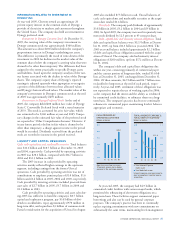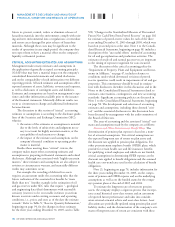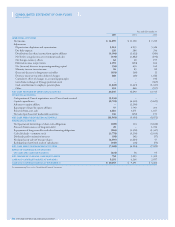Chevron 2005 Annual Report Download - page 48
Download and view the complete annual report
Please find page 48 of the 2005 Chevron annual report below. You can navigate through the pages in the report by either clicking on the pages listed below, or by using the keyword search tool below to find specific information within the annual report.
MANAGEMENT’S DISCUSSION AND ANALYSIS OF
FINANCIAL CONDITION AND RESULTS OF OPERATIONS
46 CHEVRON CORPORATION 2005 ANNUAL REPORT
future to: prevent, control, reduce or eliminate releases of
hazardous materials into the environment; comply with exist-
ing and new environmental laws or regulations; or remediate
and restore areas damaged by prior releases of hazardous
materials. Although these costs may be signifi cant to the
results of operations in any single period, the company does
not expect them to have a material effect on the company’s
liquidity or fi nancial position.
CRITICAL ACCOUNTING ESTIMATES AND ASSUMPTIONS
Management makes many estimates and assumptions in
the application of generally accepted accounting principles
(GAAP) that may have a material impact on the company’s
consolidated fi nancial statements and related disclosures
and on the comparability of such information over different
reporting periods. All such estimates and assumptions affect
reported amounts of assets, liabilities, revenues and expenses,
as well as disclosures of contingent assets and liabilities.
Estimates and assumptions are based on management’s expe-
rience and other information available prior to the issuance
of the fi nancial statements. Materially different results can
occur as circumstances change and additional information
becomes known.
The discussion in this section of “critical” accounting
estimates or assumptions is according to the disclosure guide-
lines of the Securities and Exchange Commission (SEC),
wherein:
1. the nature of the estimates or assumptions is material
due to the levels of subjectivity and judgment neces-
sary to account for highly uncertain matters, or the
susceptibility of such matters to change;
2. the impact of the estimates and assumptions on the
company’s fi nancial condition or operating perfor-
mance is material.
Besides those meeting these “critical” criteria, the
company makes many other accounting estimates and
assumptions in preparing its fi nancial statements and related
disclosures. Although not associated with “highly uncertain
matters,” these estimates and assumptions are also subject to
revision as circumstances warrant, and materially different
results may sometimes occur.
For example, the recording of deferred tax assets
requires an assessment under the accounting rules that the
future realization of the associated tax benefi ts be “more
likely than not.” Another example is the estimation of oil
and gas reserves under SEC rules that require “...geological
and engineering data (that) demonstrate with reasonable
certainty (reserves) to be recoverable in future years from
known reservoirs under existing economic and operating
conditions, i.e., prices and costs as of the date the estimate
is made.” Refer to Table V, “Reserve Quantity Information,”
beginning on page 94, for the changes in these estimates
for the three years ending December 31, 2005, and to Table
VII, “Changes in the Standardized Measure of Discounted
Future Net Cash Flows From Proved Reserves” on page 102
for estimates of proved-reserve values for each of the three
years ending December 31, 2003 through 2005, which were
based on year-end prices at the time. Note 1 to the Consoli-
dated Financial Statements, beginning on page 58, includes a
description of the “successful efforts” method of accounting
for oil and gas exploration and production activities. The
estimates of crude oil and natural gas reserves are important
to the timing of expense recognition for costs incurred.
The discussion of the critical accounting policy for
“Impairment of Property, Plant and Equipment and Invest-
ments in Affi liates,” on page 47, includes reference to
conditions under which downward revisions of proved
reserve quantities could result in impairments of oil and gas
properties. This commentary should be read in conjunc-
tion with disclosures elsewhere in this discussion and in the
Notes to the Consolidated Financial Statements related to
estimates, uncertainties, contingencies and new accounting
standards. Signifi cant accounting policies are discussed in
Note 1 to the Consolidated Financial Statements, beginning
on page 58. The development and selection of accounting
estimates and assumptions, including those deemed “criti-
cal,” and the associated disclosures in this discussion have
been discussed by management with the audit committee of
the Board of Directors.
The areas of accounting and the associated “critical” esti-
mates and assumptions made by the company are as follows:
Pension and Other Postretirement Benefi t Plans The
determination of pension plan expense is based on a num-
ber of actuarial assumptions. Two critical assumptions are
the expected long-term rate of return on plan assets and
the discount rate applied to pension plan obligations. For
other postretirement employee benefi t (OPEB) plans, which
provide for certain health care and life insurance benefi ts
for qualifying retired employees and which are not funded,
critical assumptions in determining OPEB expense are the
discount rate applied to benefi t obligations and the assumed
health care cost-trend rates used in the calculation of benefi t
obligations.
Note 21, beginning on page 74, includes information for
the three years ending December 31, 2005, on the compo-
nents of pension and OPEB expense and on the underlying
assumptions as well as on the funded status for the compa-
ny’s pension plans at the end of 2005 and 2004.
To estimate the long-term rate of return on pension
assets, the company employs a rigorous process that incorpo-
rates actual historical asset-class returns and an assessment
of expected future performance and takes into consider-
ation external actuarial advice and asset-class factors. Asset
allocations are periodically updated using pension plan asset/
liability studies, and the determination of the company’s esti-
mates of long-term rates of return are consistent with these
























